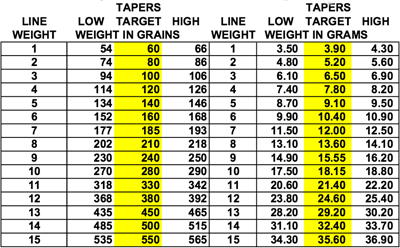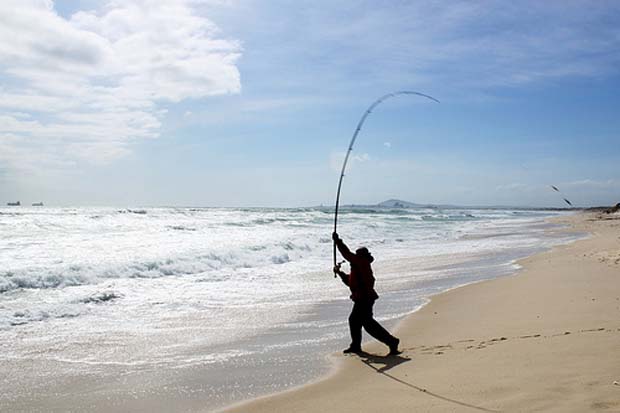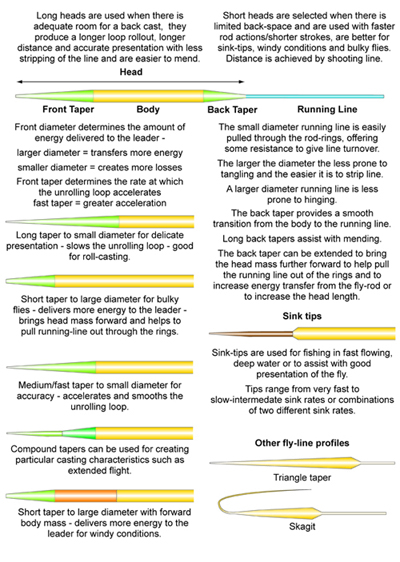Choosing a fly line
[dropcap]A[/dropcap]long with the rod and your input, the fly line taper determines how the fly is delivered to the species being fished for. Is it a delicate landing you want? Is it a power cast you want?
A fly line is either floating or sinking at a designated rate. A fly line can be clear or any color. In conventional 9-foot and under rod lengths, choices are not necessarily limited to a rod manufactures designation of weight. For instance, is it a rule that an 8-weight rod ‘requires’ an 8-weight fly line? In many cases a caster will overline a fast-action rod by one or two line weights – importing more feel by slowing down a rod’s designed fast action. By overlining or underlining to get the results wanted is a lot cheaper than buying a new fly rod. Overlining and underlining are personal preferences and done to support ones own abilities.
Types of taper
Level (L), Weight Forward (WF), Double Taper (DT), Shooting Taper (ST). Specialty Tapers are variations of Weight Forward and Double Tapers. Weight Forward configurations are most popular for a variety of reasons and have more variations.

American Fly Fishing Trade Association approved fly line weight (in grains or grams) specifications. This is a measure of the weight of the first 30-feet of fly line . . . excluding the level tip which attaches to the leader.
Grain weights are measured for the first 30-feet of fly line – minus the level tip
Knowing a line’s grain weight could advantage fishing for a specific species. For example, a Palm Beach, Florida friend loads his 12-weight with a 550 grain weight fly line, which gets him down to 70-feet pretty quickly. He says: “That is where most of my better catches of kings takes place.” A 550 grain weight line is appropriate (see chart) for a 15-weight rod.
Fly line material components
A fly line is made up of four parts. One is the core; two is the coating; three is the taper and four is the line weight or grain window designations.
It’s all in the taper
The taper of a fly line is the entire castability story. Assuming, of course, we’re not taking a tropical line to steelhead fish Pennsylvania’s Elk Creek in February, or a coldwater line to the Florida Keys in June.
A fly line taper predisposes how energy is transmitted in each fly line design. Within the scope of design are length of sections determination, and the diameters of each section of a fly line.

AFFTD two handed fly line specifications. Head length to include the head and back taper to the holding line and/or running line.
The parts of a fly line
The Tip is first foot or so of a fly line – a short, level section that the leader is attached to. If for reason of adding a new leader a portion of the Tip is shortened – it will not change how the line casts.
The First Taper or Front Taper is the section of the line determines soft, delicate landings or how powerful a cast can be made. Depending on the line weight designation, this front taper is usually 4- to 8-feet long and it lessens in diameter from the following section (Belly) to the Tip. This gradation of the line’s mass determines how you transfer casting power.
The Belly is the greatest diameter, longest length and most weight. This section is where your casting energy is carried.
The Rear Taper, which decreases in diameter from the thicker Belly to smaller diameter running line section. This transition is all about the line’s casting smoothness.
The term Head refers to front taper, belly and rear taper.
• The Running Line makes distance casting easier.
Since a Double Taper (DT) line is essentially a long belly with tapers at both ends, there is no running line by definition. This large diameter belly line does not shoot through the rod guides easily. A smaller diameter, lighter weight line creates less friction. The running line portion of Weight Forward (WF) and Shooting Taper (ST) configuration fills this role. The Head is extended through the tip of the rod. The rod is loaded with the weight of the Head. Further extension of the fly line is accomplished by stripping line from the reel and then ‘shooting’ it through the guides.
Today, fly rodders are expanding the useful duties of their individual ‘sticks’ by adding ‘lines’ to their fly line, which is much cheaper than buying two more fly rods. Think shooting head, scandi, skagit, versi tips or poly tips. All producing new ways to get longer, improve drifts or get to a preferred water column.
[information]
Sources: Cortland, Fly Fish USA, RIO Products, Lefty Kreh (numerous articles), John Symonds, Steve Kantner, American Fly Fishing Trade Association
[/information]



